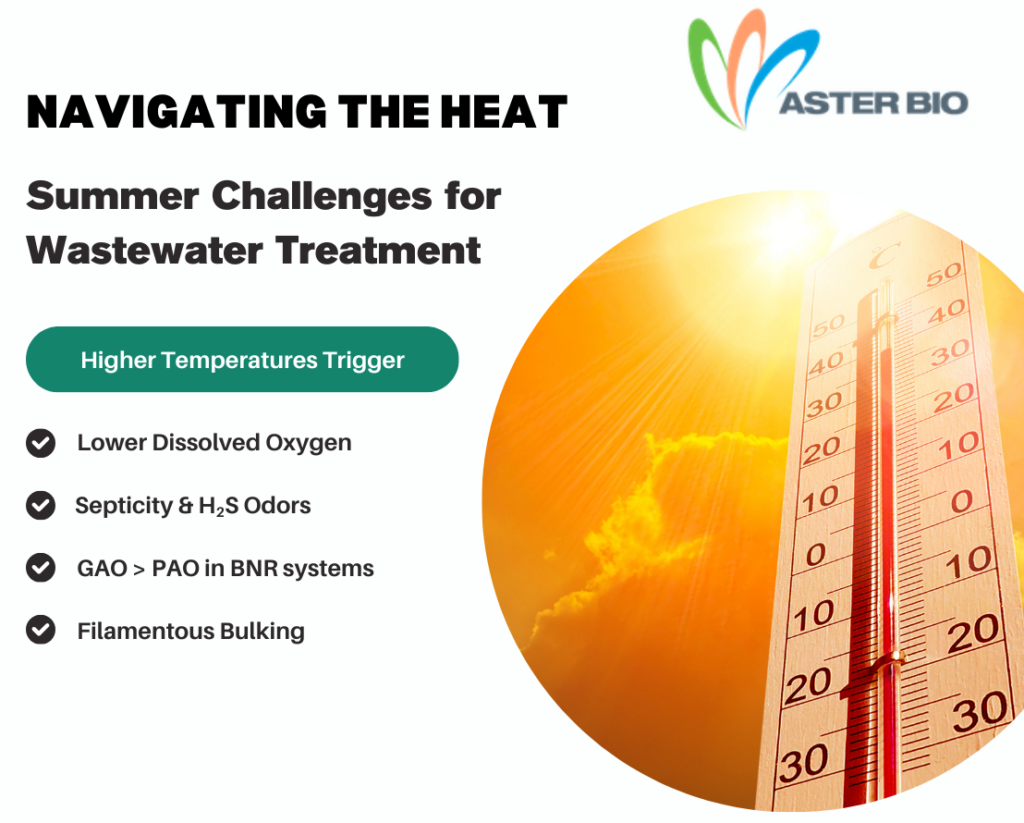
As the summer months continue, wastewater treatment plants face a surge in operational hurdles. Higher temperatures not only accelerate biological processes but also exacerbate issues like reduced oxygen levels and microbial imbalances. For operators, this means staying vigilant to maintain efficiency, prevent odors, and ensure compliance with environmental standards. In this post, we’ll dive into some of the most common summer-specific challenges: low dissolved oxygen (DO) from rising temperatures, septic influent leading to hydrogen sulfide (H2S) odors, the shift toward glycogen-accumulating organisms (GAOs) over polyphosphate-accumulating organisms (PAOs), and the proliferation of filamentous organisms under low DO and septic conditions. We’ll explore why these problems intensify in the heat and offer practical tips for mitigation.
Low Dissolved Oxygen Amid Higher Temperatures
One of the hallmark issues of summer is the drop in dissolved oxygen levels in wastewater. Warmer water holds less oxygen—solubility decreases as temperatures climb, often dipping below the critical thresholds needed for aerobic treatment processes. In activated sludge systems, this can lead to incomplete organic matter breakdown, reduced treatment efficiency, and even the promotion of anaerobic conditions.
Why it worsens in summer:
Temperatures above 25-30°C not only reduce oxygen solubility but also boost microbial metabolism, increasing oxygen demand. This double whammy is compounded by higher influent loads from seasonal activities like increased tourism or industrial outputs.
Impacts:
Low DO can cause sludge settling problems, nutrient removal failures, and the emergence of odors from anaerobic byproducts. In severe cases, it risks fish kills in receiving waters if effluent DO is too low.
Tips for operators:
- Enhance aeration: Increase blower output or add supplemental oxygen systems to maintain DO above 2 mg/L in aerobic zones.
- Monitor closely: Use real-time sensors to track temperature and DO, adjusting operations proactively.
- Optimize mixing: Ensure even distribution to prevent dead zones where DO plummets.
Septic Influent and H2S Odors
Hot weather turns collection systems into breeding grounds for septicity, where wastewater stagnates and becomes anaerobic. This leads to septic influent arriving at the plant, often laden with hydrogen sulfide (H2S)—the infamous “rotten egg” gas responsible for odors and corrosion.
Why it worsens in summer:
Lower flows from dry conditions mean longer retention times in sewers, while heat speeds up sulfate-reducing bacteria activity, producing more H2S. Dilution is minimal without rain, concentrating the problem and triggering community complaints.
Impacts:
Beyond foul smells, H2S corrodes concrete and metal infrastructure, shortening asset life and raising maintenance costs. It can also pose health risks to workers and disrupt downstream processes by inhibiting beneficial bacteria.
Tips for operators:
- Chemical dosing: Add oxidants like hydrogen peroxide or nitrate to prevent H2S formation in collection lines.
- Ventilation and scrubbing: Install biofilters or chemical scrubbers at headworks to capture odors.
- Preventive flushing: Schedule regular sewer cleaning to reduce buildup during peak heat.
GAO Increase Relative to PAO in Biological Nutrient Removal
In enhanced biological phosphorus removal (EBPR) systems, summer heat tips the microbial balance toward glycogen-accumulating organisms (GAOs) at the expense of polyphosphate-accumulating organisms (PAOs). PAOs are the heroes for phosphorus uptake, but GAOs compete for carbon sources without providing the same nutrient removal benefits.
Why it worsens in summer:
GAOs thrive at temperatures above 25°C, while PAO activity declines beyond this threshold, leading to higher GAO/PAO ratios. This shift is exacerbated by volatile fatty acid availability and can result in seasonal phosphorus removal failures.
Impacts:
Reduced EBPR efficiency means higher effluent phosphorus levels, risking regulatory violations and eutrophication in waterways. It also increases chemical dosing needs for phosphorus precipitation.
Tips for operators:
- Adjust carbon ratios: Optimize volatile fatty acid feeds to favor PAOs, perhaps through sidestream fermentation.
- Temperature control: Where feasible, shade or cool anaerobic zones to keep temps below 25°C.
- Microbial monitoring: Use qPCR or MCA testing to track GAO/PAO populations and intervene early.
Low DO and Septic Conditions Fueling Filamentous Organisms
Filamentous bacteria are a normal part of activated sludge, but low DO and septic influent in summer can cause their overgrowth, leading to bulking and foaming. These “filaments” form long chains that hinder sludge settling.
Why it worsens in summer:
Low oxygen environments select for filaments like Thiothrix or N. limicola, which outcompete floc-formers. Septic conditions add sulfides that further promote certain types, worsening bulking.
Impacts:
Poor settling results in higher suspended solids in effluent, reduced clarifier performance, and potential carryover to disinfection stages. Foaming can also create safety hazards and aesthetic issues.
Tips for operators:
- Boost DO: Target 1-2 mg/L in mixed liquor to suppress filaments.
- Selective controls: Apply chlorination or ozone to target filaments without harming the overall biomass.
- Nutrient balance for industrial wastewaters: Ensure adequate nitrogen and phosphorus to prevent deficiencies that favor filaments.
